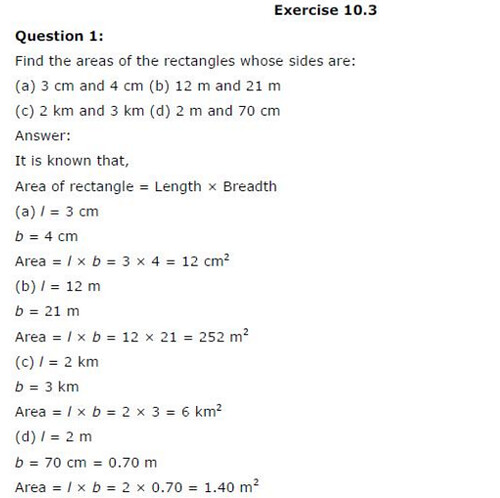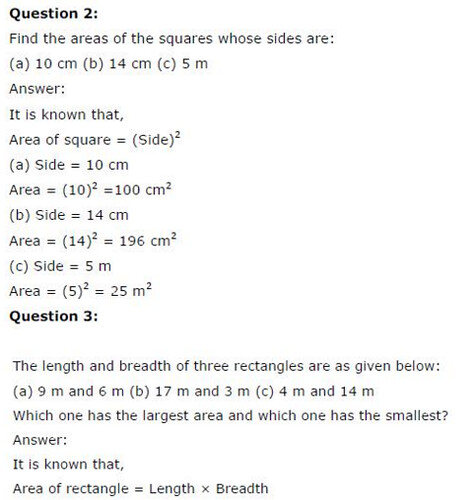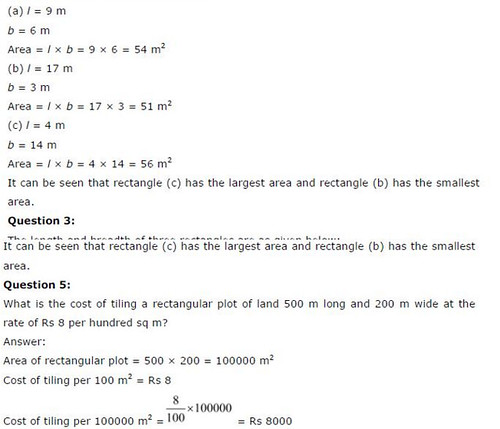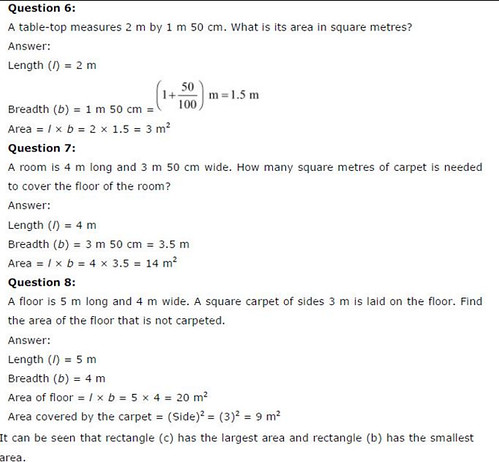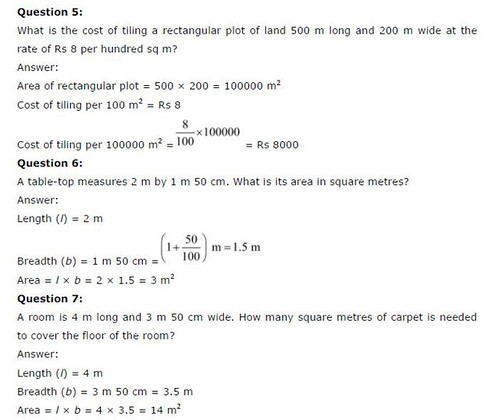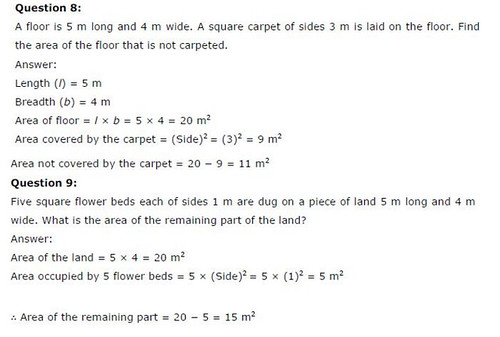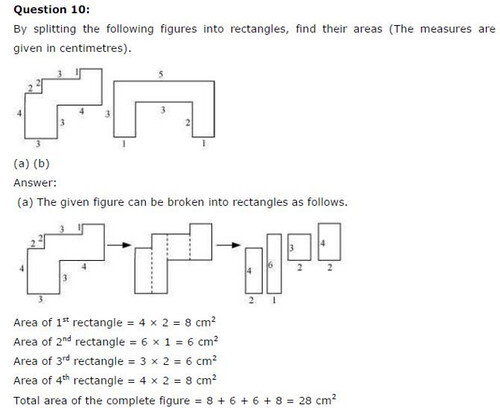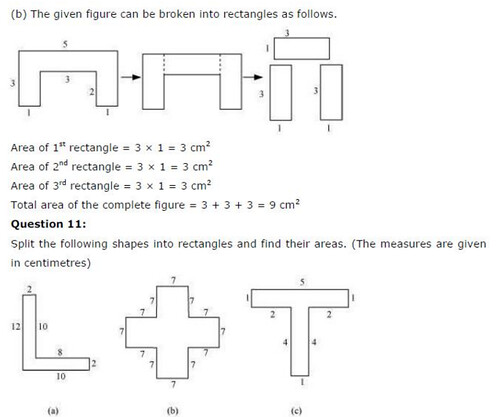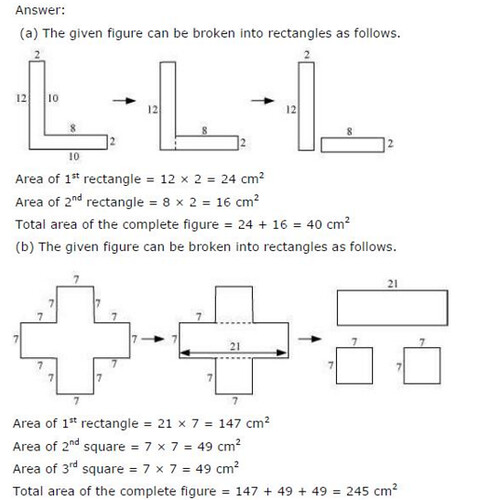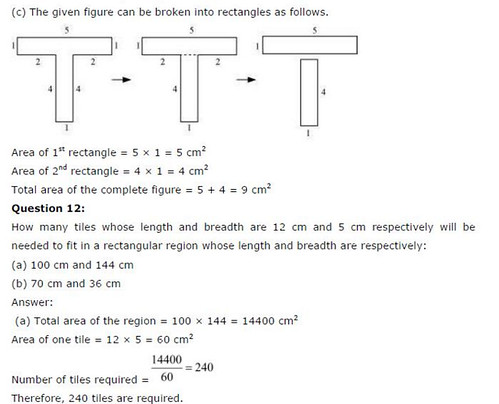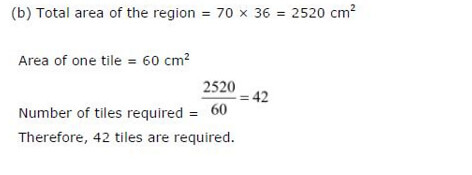NCERT Solutions For Class 6 Maths Chapter 10 Mensuration
NCERT Solutions For Class 6 Maths Chapter 10 Mensuration Ex 10.1
Exercise 10.1
Ex 10.1 Class 6 Maths Question 1.
Find the perimeter of each of the following figures:
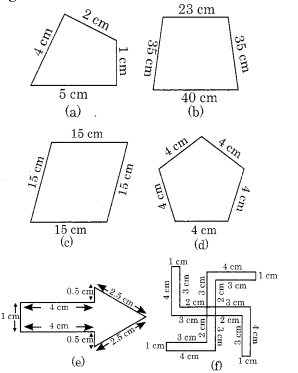
Solution:
(a) Required perimeter
= 4 cm + 2 cm + 1 cm + 5 cm = 12 cm
(b) Required perimeter
= 40 cm + 35 cm + 23 cm + 35 cm
= 133 cm or 1.33 m
(c) Required perimeter
= 15 cm + 15 cm + 15 cm + 15 cm = 15 cm x 4 = 60 cm
(d) Required perimeter
= 4 cm + 4 cm + 4 cm + 4 cm + 4 cm – 4 cm x 5 = 20 cm
(e) Required perimeter
= 4 cm + 0.5 cm + 2.5 cm + 2.5 cm + 0.5 cm + 4 cm + 1 cm
= 15 cm
(f) Required perimeter = 4 cm + 1 cm + 3 cm + 2 cm + 3 cm + 4 cm + 1 cm + 3 cm + 2 cm + 3 cm + 4 cm + 1 cm + 3 cm + 2 cm + 3 cm + 4 cm + 1 cm + 3 cm + 2 cm + 3 cm
= 52 cm
Ex 10.1 Class 6 Maths Question 2.
The lid of a rectangular box of sides 40 cm by 10 cm is sealed all round with tape. What is the length of the tape required?
Solution:
Total length of the tape required = perimeter of the rectangular lid
= 2 [length + breadth] = 2 x [40 + 10]
= 2 x 50 = 100 cm
Ex 10.1 Class 6 Maths Question 3.
A table-top measures 2 m 25 cm by 1 m 50 cm. What is the perimeter of the table-top?
Solution:
Length of table-top = 2 m 25 cm
Breadth of table-top = 1 m 50 cm
∴ Perimeter of the table top = 2 [length + breadth]
= 2 [2 m 25 cm + 1 m 50 cm]
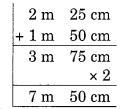
= 2 x 3 m 75 cm
= 7 m 50 cm
= 7.5 m
Ex 10.1 Class 6 Maths Question 4.
What is the length of the wooden strip required to frame a photograph of length and breadth 32 cm and 21 cm respectively?
Solution:
Length of the strip = 32 cm
Breadth of the strip = 21 cm
∴ Perimeter = 2 [length + breadth]
= 2 [32 cm + 21 cm]
= 2 x 53 cm = 106 cm
Hence, the required length of the strip = 106 cm or 1 m 6 cm.
Ex 10.1 Class 6 Maths Question 5.
A rectangular piece of land measures 0.7 km by 0.5 km. Each side is to be fenced with 4 rows of wires. What is the length of the wire needed?
Solution:
Length of the rectangular piece of land = 0.7 km = 0.7 x 1000 m = 700 m
Breadth of the rectangular piece of land = 0.5 km = 0.5 x 1000 m = 500 m
∴ Perimeter of the rectangular land
= 2 [length + breadth]
= 2 [700 m + 500 m]
= 2400 m.
Length of wire needed in 4 rounds of the land = 4 x 2400 = 9600 m = 9.6 km.
Ex 10.1 Class 6 Maths Question 6.
Find the perimeter of each of the following shapes:
(a) A triangle of sides 3 cm, 4 cm and 5 cm.
(b) An equilateral triangle of side 9 cm.
(c) An isosceles triangle with equal sides 8 cm each and third side 6 cm.
Solution:
(a) We know that the perimeter of the given triangle = The sum of all sides of the triangle
∴ Perimeter of the triangle = 3 cm + 4 cm + 5 cm = 12 cm
(b) We know that the perimeter of the given triangle
= Sum of all the sides of the triangle
= (9 + 9 + 9) = 27 cm
(c) Perimeter of the given isosceles triangle
= Sum of all the sides of the triangle
= (8 + 8 + 6) cm = 22 cm
Ex 10.1 Class 6 Maths Question 7.
Find the perimeter of a triangle with sides measuring 10 cm, 14 cm and 15 cm.
Solution:
Perimeter of a triangle = Sum of all the sides of the triangle
= 10 cm + 14 cm + 15 cm
= 39 cm
Ex 10.1 Class 6 Maths Question 8.
Find the perimeter of a regular hexagon with each side measuring 8 m.
Solution:
Perimeter of a regular hexagon = 6 x side = 6 x 8 m = 48 m.
Ex 10.1 Class 6 Maths Question 9.
Find the side of the square whose perimeter is 20 m.
Solution:
Perimeter of a square = 4 x side
20 = 4 x side
∴ side = 20 m ÷ 4 = 5 m
Ex 10.1 Class 6 Maths Question 10.
The perimeter of a regular pentagon is 100 cm. How long is its each side?
Solution:
We have
Perimeter of the regular pentagon = 100 cm
Number of sides in regular pentagon = 5
∴ Length of each side = Perimeter ÷ Number of sides
= 100 cm ÷ 5 = 20 cm.
Ex 10.1 Class 6 Maths Question 11.
A piece of string is 30 cm long. What will be the length of each side if the string is used to form:
(a) a square?
(b) an equilateral triangle?
(c) a regular hexagon?
Solution:
(a) Length of string = 30 cm
Number of equal sides in a square = 4
∴ Length of each side of the square = 30 cm ÷ 4 = 7.50 cm.
(b) Length of string = 30 cm
Number of equal sides in equilateral triangle = 3
∴ Length of each side of the equilateral triangle = 30 cm ÷ 3 = 10 cm
(c) Length of string = 30 cm
Number of equal sides in regular hexagon = 6
∴ Length of each side of the regular hexagon = 30 cm ÷ 6 = 5 cm
Ex 10.1 Class 6 Maths Question 12.
Two sides of a triangle are 12 cm and 14 cm. The perimeter of the triangle is 36 cm. What is its third side?
Solution:
Perimeter of the triangle = 36 cm.
Length of two of its sides are 12 cm and 14 cm.
Length of the third side of the triangle = 36 – (12 + 14) cm
= (36 – 26) cm = 10 cm
Ex 10.1 Class 6 Maths Question 13.
Find the cost of fencing a square park of side 250 m at the rate of? 20 per metre.
Solution:
Length of the side of a square = 250 m
∴ Perimeter of the square = 250 m x 4 = 1000 m
Rate of fencing = ₹20 per m.
∴ Cost of fencing = ₹20 x 1000 = ₹20,000
Ex 10.1 Class 6 Maths Question 14.
Find the cost of fencing a rectangular park of length 175 m and breadth 125 m at the rate of ₹12 per metre.
Solution:
Length of the rectangular park = 175 m
Breadth of the rectangular park = 125 m
∴ Perimeter of the park = 2 [length + breadth]
= 2[175 m + 125 m]
= 2 x 300 m = 600 m
Rate of fencing = ₹ 12 per metre Cost of fencing = ₹12 x 600 = ₹7200
Ex 10.1 Class 6 Maths Question 15.
Sweety runs around a square park of side 75 m. Bulbul runs around a rectangular park with length 60 m and breadth 45 m. Who covers less distance?
Solution:
Side of the square park = 75 m
∴ its perimeter = 4 x 75 m = 300 m
Perimeter of the rectangular park = 2 [length + breadth]
= 2 [60 m + 45 m]
= 2 x 105 m = 210 m.
Since 210 m < 300 m.
So, Bulbul covers less distance.
Ex 10.1 Class 6 Maths Question 16.
What is the perimeter of each of the following figures? What do you infer from the answers?
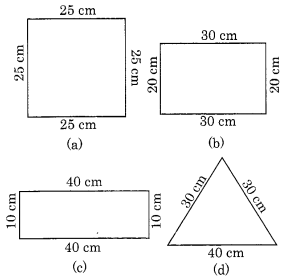
Solution:
(a) Perimeter of the square = 25 cm + 25 cm + 25 cm + 25 cm = 4 x 25 cm = 100 cm
(b) Perimeter of the rectangle = 30 cm + 20 cm + 30 cm + 20 cm – 2 [30 cm + 20 cm] = 2 x 50 cm = 100 cm
(c) Perimeter of the rectangle = 40 cm + 10 cm + 40 cm + 10 cm = 2 [40 cm + 10 cm] = 2 x 50 cm = 100 cm
(d) Perimeter of the triangle = Sum of all sides = 30 cm + 30 cm + 40 cm = 100 cm From the above answers, we conclude that different figures may have equal perimeters.
Ex 10.1 Class 6 Maths Question 17.
Avneet buys 9 square paving slabs, each with a side of 17 m. He lays them in the form of a square.
(a) What is the perimeter of his arrangement [Fig. (i)]?
(b) Shari does not like his arrangement. She gets him to lay them out like a cross. What is the perimeter of her arrangement [Fig. (ii)]?
(c) Which has greater perimeter?
(d) Avneet wonders, if there is a way of getting an even greater perimeter. Can you find a way of doing this? (The paving slabs must meet along complete edges, i.e., they can not be broken).
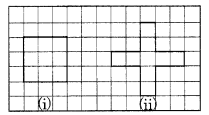
Solution:
(a) The arrangement is in the form of a square of side
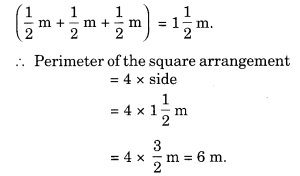
(b) Perimeter of cross-arrangement

(c) Since 10 m > 6 m
∴ Cross-arrangement has greater perimeter.
(d) Total number of tiles = 9
∴ We have the following arrangement

The above arrangement will also have the greater perimeter.
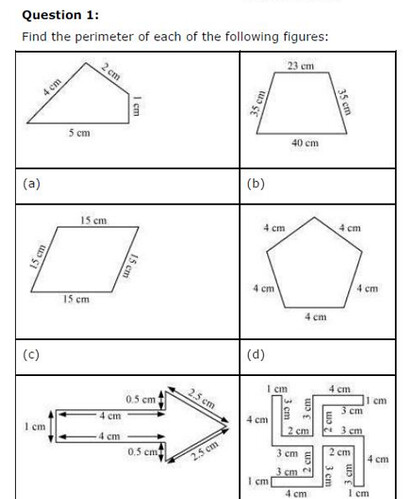
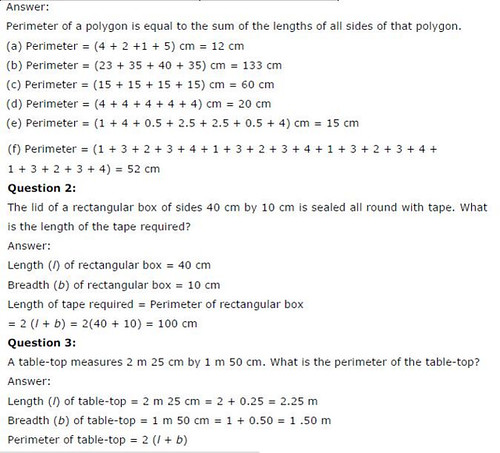
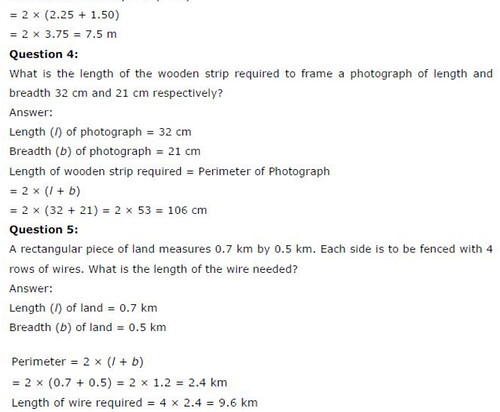
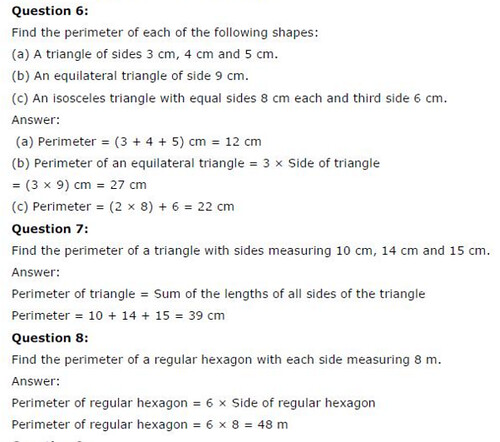
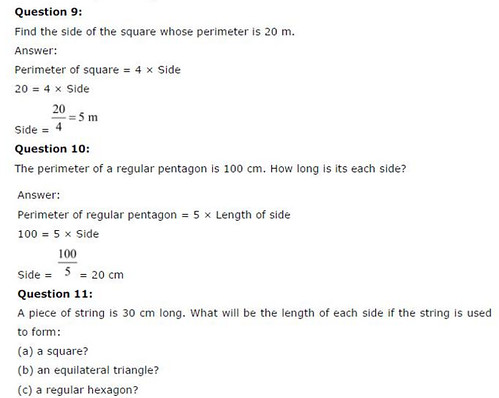
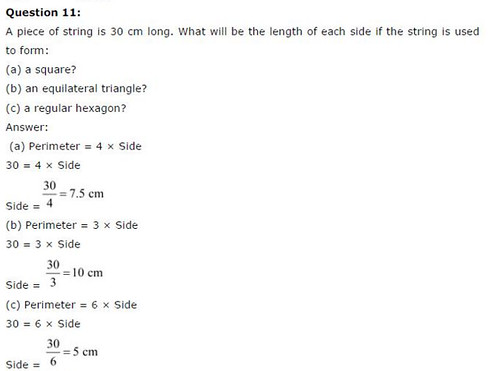
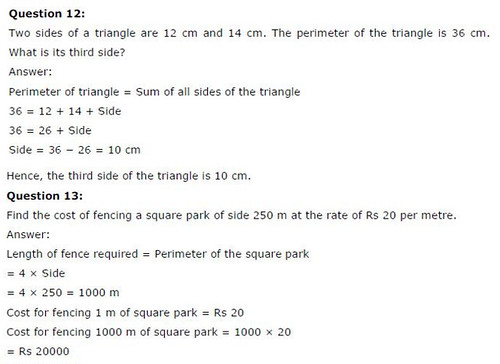
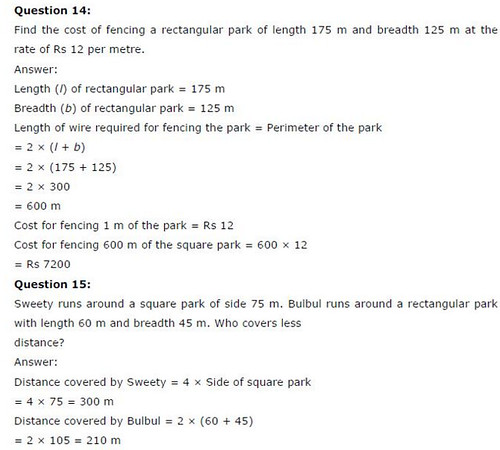
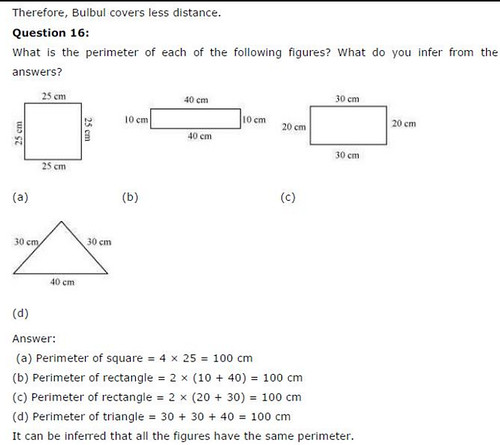
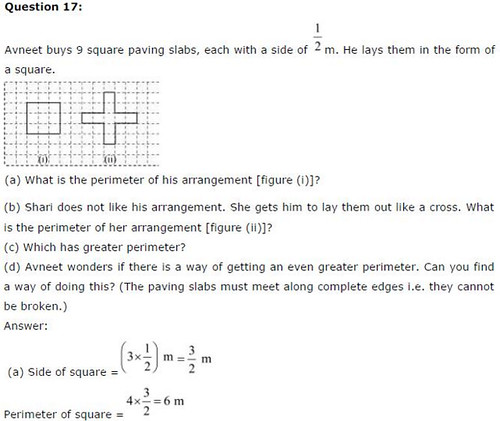
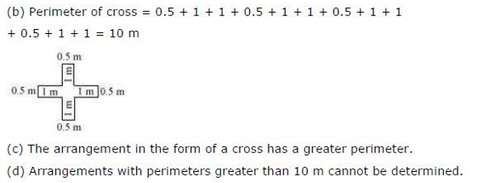
NCERT Solutions For Class 6 Maths Chapter 10 Mensuration Ex 10.2
Exercise 10.2
Ex 10.2 Class 6 Maths Question 1.
Find the areas of the following figures by counting square:
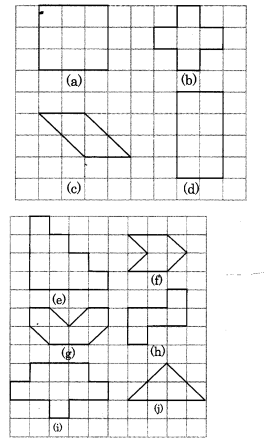
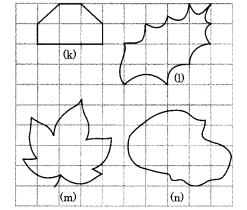
Solution:
(a) Number of full squares = 9
Area of 1 square = 1 sq unit
∴ Area of 9 squares = 9 x 1 sq unit
= 9 sq units.
So, the area of the portion covered by 9 squares = 9 sq units
(b) Number of full squares = 5
∴ Area of the figure = 5 x 1 sq unit = 5 sq units
(c) Number of full squares = 2
Number of half squares = 4
∴ Area of the covered figure = 2 x 1 + 4 x 12 = 2 + 2
= 4 sq units
(d) Number of full squares = 8
∴ Area of the covered portion of the figure = 8 x 1 sq unit
= 8 sq units.
(e) Number of full squares = 10
Area covered by the figure = 10 x 1 sq unit = 10 sq units.
(f) Number of full squares = 2
Number of half squares = 4
∴ Area of the covered figure = (2 x 1 + 4 x 12)
= (2 + 2) sq units = 4 sq units.
(g) Number of full squares = 4
Number of half squares = 4
∴ Area of the covered figure = (4 x 1 + 4 x 12)
= (4 + 2) sq units = 6 sq units.
(h) Number of full squares = 5
∴ Area of the covered figure = 5 x 1 sq unit = 5 sq units.
(i) Number of full squares = 9
∴ Area of the covered figure = 9 x 1 sq units
= 9 sq units.
(j) Number of full squares = 2
Number of half squares = 4
∴ Area of the covered figure =(2 x 1 + 4 x 12) sq units
= (2 + 2) sq units = 4 sq units.
(k) Number of full squares = 4
Number of half squares = 2
∴ Area of the covered figure = (4 x 1 + 2 x 12)sq units
= (4 + 4)sq units
= 5sq units
(l) Number of full squares = 4
Number of squares more than half = 3
Number of half squares = 2
∴ Area of the covered figure = (4 x 1 + 3 x 1 + 2 x 12 sq units
= (4 + 3 + 1) sq units = 8 sq units.
(m) Number of full squares = 6
Number of more than half squares = 8
Area of the covered figure = (6 x 1 + 8 x 1) sq units
= (6 + 8) sq units
= 14 sq units.
(n) Number of full squares = 9
Number of more than half squares = 9
∴ Area of the covered figure
= (9 x 1 + 9 x 1) sq units
= (9 + 9) sq units = 18 sq units.
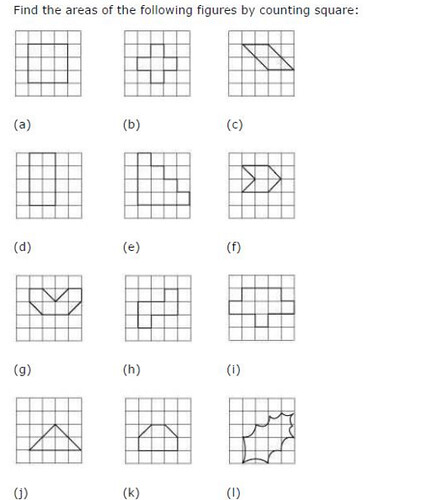
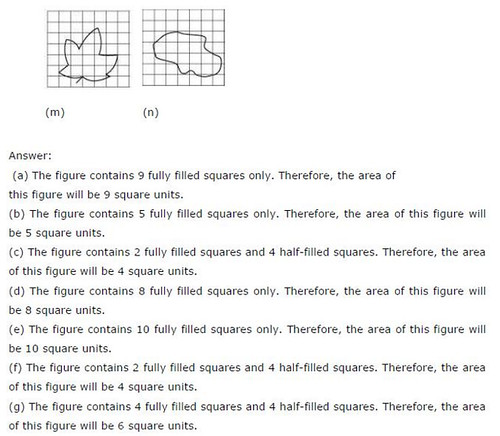
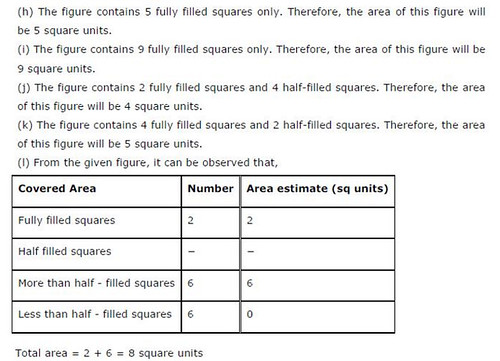
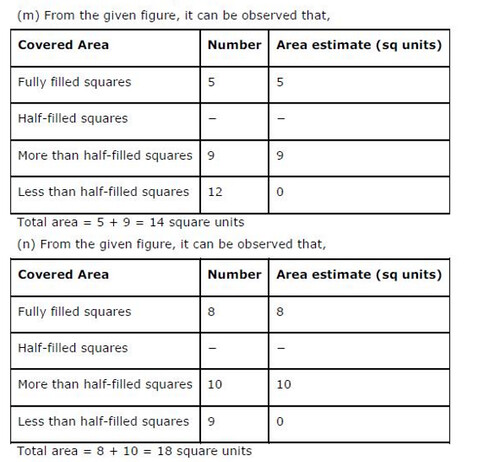
NCERT Solutions For Class 6 Maths Chapter 10 Mensuration Ex 10.3
Exercise 10.3
Ex 10.3 Class 6 Maths Question 1.
Find the areas of the rectangles whose sides are:
(a) 3 cm and 4 cm
(b) 12 m and 21 m
(c) 2 km and 3 km
(d) 2 m and 70 cm
Solution:
(a) Length of the rectangle = 3 cm
Breadth of the rectangle = 4 cm
∴ Area of the rectangle = length x breadth = 3 cm x 4 cm
= 12 cm2 or 12 sq cm
(b) Length of the rectangle = 12 m and breadth = 21 m
∴ Area of the rectangle = length x breadth = 12 m x 21 m
= 252 m2 or 252 sq m
(c) Length of the rectangle = 2 km and breadth 3 km
∴ Area of the rectangle = length x breadth = 2 km x 3 km
= 6 km2 or 6 sq km
(d) Length of the rectangle = 2 m
and breadth = 70 cm or 0.70 m
∴ Area of the rectangle = length x breadth = 2 m x 0.70 m
= 1.40 m2 or 1.40 sq m
Ex 10.3 Class 6 Maths Question 2.
Find the areas of the squares whose sides are:
(a) 10 cm
(b) 14 cm
(c) 5 m
Solution:
(a) Side of the square = 10 cm
∴ Area of the square = Side x Side = 10 cm x 10 cm = 100 cm2 or 100 sq cm
(b) Side of the square = 14 cm
∴ Area of the square = Side x Side = 14 cm x 14 cm = 196 cm2 or 196 sq cm
(c) Side of the square = 5 m
∴ Area of the square = Side x Side = 5 m x 5 m = 25 m2 or 25 sq m
Ex 10.3 Class 6 Maths Question 3.
The length and breadth of three rectangles are as given below:
(a) 9 m and 6 m
(b) 17 m and 3 m
(c) 4 m and 14 m
Which one has the largest area and which one has the smallest?
Solution:
(a) Length of the rectangle = 9 m
and breadth = 6 m
∴ Area of the rectangle = length x breadth
= 9 m x 6 m
= 54 m2 or 54 sq m
(b) Length of the rectangle = 17 m
and breadth = 3m
∴ Area of the rectangle
= length x breadth = 17 m x 3 m 51 m2 or 51 sq m
(c) Length of the rectangle = 4 m
and breadth = 14 m
Area of the rectangle = length x breadth
= 4 m x 14 m
= 56 m2 or 56 sq m
Rectangle (c) has the largest area, i.e., 56 sq m and Rectangle (b) has the smallest area, i.e., 51 sq m.
Ex 10.3 Class 6 Maths Question 4.
The area of a rectangular garden 50 m long is 300 sq m. Find the width of the garden.
Solution:
Length of the rectangular garden = 50 m
Area of the rectangular garden = 300 sq m
∴ Width = Area ÷ Length
= 300 sq m ÷ 50 m = 6 m
Hence width of the garden = 6 m.
Ex 10.3 Class 6 Maths Question 5.
What is the cost of tiling a rectangular plot of land 500 m long and 200 m wide at the rate of ₹8 per hundred sq m?
Solution:
Length of the rectangular plot = 500 m
and the breadth = 200 m
∴ Area of the plot = length x breadth = 500 m x 200 m = 100000 sq m
Now rate of tiling the plot = ₹8 per 100 sq m
Cost of tiling the garden = ₹(8100x 100000 ) = ₹8000
Hence the required cost = ₹8000
Ex 10.3 Class 6 Maths Question 6.
A table-top measures 2 m by 1 m 50 cm. What is its area in square metres?
Solution:
Length of the table-top = 2 m
and its breadth = 1 m 50 cm or 1.50 m
∴ Area of the table-top = length x breadth
= 2 m x 1.50 m
= 3 m2 or 3 sq m
Hence, the area of table-top = 3 sq m.
Ex 10.3 Class 6 Maths Question 7.
A room is 4 m long and 3 m 50 cm wide. How many square metres of carpet is needed to cover the floor of the room?
Solution:
Length of the room = 4 m
and its breadth = 3 m 50 cm = 3.5 m
Area of the room = length x breadth
= 4 m x 3.5 m = 14 sq m
Hence, the area of the carpet needed = 14 sq m
Ex 10.3 Class 6 Maths Question 8.
A floor is 5 m long and 4 m wide. A square carpet of sides 3 m is laid on the floor. Find the area of the floor that is not carpeted.
Solution:
Length of the floor = 5 m
and its breadth = 4 m
∴ Area of the floor = length x breadth
= 5m x 4m = 20sqm
Side of the carpet = 3m
∴ Area of the square carpet = side x side = 3m x 3m = 9 sqm
∴ Area of the floor which is not carpeted = 20 sq m – 9 sq m
= 11 sq m.
Ex 10.3 Class 6 Maths Question 9.
Five square flower beds each of side 1 m are dug on a piece of land 5 m long and 4 m wide. What is the area of the remaining part of the land?
Solution:
Side of the square flower bed = 1 m.
∴ Area of 1 square flower bed = 1m x 1m = 1sqm.
∴ Area of 5 square flower beds = 1 sq m x 5 = 5 sq m.
Now length of the land = 5 m
and its breadth = 4 m
∴ Area of the land = length x breadth =5m x 4m = 20 sq m
∴ Area of the remaining part of the land = 20 sq m – 5 sq m
= 15 sq m.
Ex 10.3 Class 6 Maths Question 10.
By splitting the following figures into rectangles, find their areas (The measures are given in centimetres).
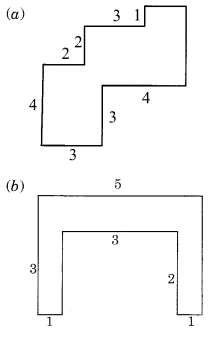
Solution:
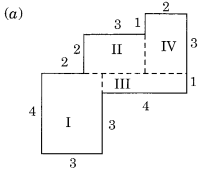
Splitting the given figure into the rectangles I, II, III and IV, we have
Area of the rectangle I = length x breadth
= 4 cm x 3 cm = 12 sq cm
Area of the rectangle II = length x breadth
= 3 cm x 2 cm = 6 sq cm.
Area of the rectangle III = length x breadth
= 4 cm x 1 cm = 4 sq cm
Area of the rectangle IV = length x breadth
= 3 cm x 2 cm = 6 sq cm
∴ Total area of the whole figure
= 12 sq cm + 6 sq cm + 4 sq cm + 6 sq cm
= 28 sq cm.
(b) Splitting the given figure into the rectangles I, II and III, we get
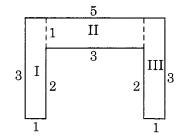
Area of the rectangle I
= 12 cm x 2 cm = 24 sq cm
Area of the rectangle II
= 8 cm x 2 cm = 16 sq cm
Area of rectangle III
= 3 cm x 1 cm = 3 sq cm
∴ Total area of the given figure = 3 sq cm + 3 sq cm + 3 sq cm = 9 sq cm.
Ex 10.3 Class 6 Maths Question 11.
Split the following shapes into rectangles and find their areas (The measures are given in centimetres).
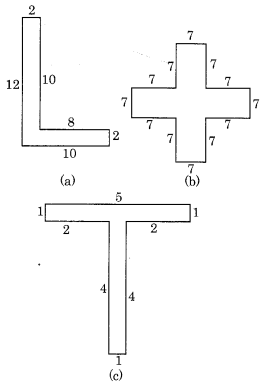
Solution:
(a) Splitting the given figure into the rectangles I and II, we get
Area of the rectangle I
= 12 cm x 2 cm = 24 sq cm
Area of the rectangle II
= 8 cm x 2 cm = 16 sq cm
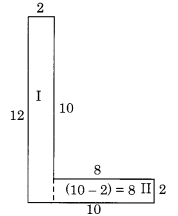
∴ Total area of the whole figure = 24 sq cm + 16 sq cm = 40 sq cm.
(b) Splitting the given figure into the rectangles I, II and III, we get
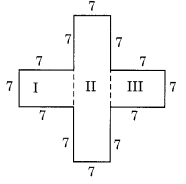
Area of the rectangle I
= 7 cm x 7 cm = 49 sq cm
Area of the rectangle II
= 21 cm x 7 cm = 147 sq cm
Area of the rectangle III
= 7 cm x 7 cm = 49 sq cm
∴ Total area of the whole figure
= 49 sq cm + 147 sq cm + 49 sq cm
= 245 sq cm.
Ex 10.3 Class 6 Maths Question 12.
How many tiles whose length and breadth are 12 cm and 5 cm respectively will be needed to fit in a rectangular region whose length and breadth are respectively:
(a) 100 cm and 144 cm
(b) 70 cm and 36 cm
Solution:
Length of one tile = 12 cm
Breadth of the tile = 5 cm
∴ Area of 1 tile = length x breadth = 12 cm x 5 cm = 60 sq cm
(a) Length of the rectangular region = 144 cm
Breadth of the region = 100 cm
∴ Area of the rectangular region = length x breadth = 144 cm x 100 cm
= 14400 sq cm
∴ Number of tiles needed to cover the whole rectangular region
= 14400 sq cm ÷ 60 sq cm
= 240 tiles
(b) Length of the rectangular region = 70 cm
Breadth of the region = 36 cm
∴ Area of the rectangular region = length x breadth = 70 cm x 36 cm = 2520 sq cm
∴ Number of tiles needed to cover the whole rectangular region
= 2520 sq cm ÷ 60 sq cm
= 42 tiles.
